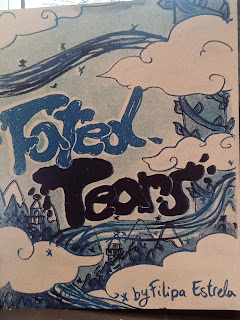Coco Fox's middle-grade quasi-memoir Let's Go, Coco! is a delightful breath of fresh air in the genre. It's not a surprise that Harper Alley is the publisher, considering that they also published quirky quasi-memoirs by Jarad Greene and Colleen Frakes. Fox's is interesting because her expressive but super minimalistic style feels like it should be aimed at emerging readers, but the themes of budding pre-adolescent feelings and complex friendship dynamics put it squarely into middle-grade territory.
I actually saw Fox present this when I sat in on a class at CCS six years ago. What's interesting is that while Fox hasn't altered their style that much from when I first saw it as a draftsman, it's clear that their cartooning is so much more confident and sophisticated. The original title of the book, Right To Left, was a much better one than the generic title used here, and much more visually evocative of the plot. The plot follows young Coco into her sixth-grade year, where she will have to face life without her best friend Blair, who moves away from their small town in Indiana. Coco decides to face her anxieties and joins the basketball team.
Fox manages to delineate each of her teammates clearly. Maddie is a sarcastic bully who is talented. Coco has a crush on Tami, the team captain and mastermind. Vera is a nerdy goofball. Zander is a non-binary kid. A crucial aspect of the book is that Fox takes the basketball portions very seriously. She explains it in such a way that a non-fan can understand, but when she started to explain what a pick was very early on, I knew she wasn't going to shrink away from the importance of the actual game. This was a smart move because team politics and team drama became an important part of the plot. When Coco accidentally has her wrist broken by her coaching when attempting to demonstrate how to block a shot, her dominant hand is put in a cast. Being forced to use her left hand forms the majority of the action in the back half of the book and directly relates to how her cheerful and non-confrontational nature was used against her by those willing to exploit it or ignore her other emotions.
There's a lot to sort out in the narrative as a result of having several important characters, but Fox never loses sight of Coco as a well-meaning protagonist who has a lot of learning to do about asserting herself. Her cartooning is so wonderfully alive and expressive, as she's able to generate a big emotional impact with simply-drawn facial expressions and gestures. It greatly helps that the color is a fairly muted two-tone affair, focusing mostly on light purples and shades of orange. Fox's line is strong and steady throughout and never gets lost in the coloring. I love that the book doesn't shy away from Coco's feelings toward one of her teammates, nor does it treat Zander with anything but respect. These days, that's a bold move for a publisher. There is a sweetness and sincerity in this narrative that was clearly entertaining for me, but I imagine that it will truly resonate with its target audience.





















































